Blackfoot River Fishing Guide
Montana Trout Outfitters – Tony Reinhardt
The Blackfoot river near Missoula was made legendary by the movie, A River Runs Through It. This iconic stream is one of the most scenic Montana rivers and offers excellent fly fishing opportunities.
Over 40 years of dedicated conservation efforts have restored the Blackfoot river to its former glory. It is a stronghold for native trout including west slope cutthroat and bull trout. It also boasts healthy populations of rainbow trout and brown trout. This is one of the few rivers where anglers have a legitimate shot at a Grand Slam with 4 different trout species in one day.

Blackfoot River Fishing Guide Map
Most flyfishing guides and anglers focus their attention on stretches of the Blackfoot river between the towns of Ovando on the upper river and Bonner located downstream near the confluence with the Clark Fork. There are some good wade fishing opportunities further upstream from Ovando all the way to the small town of Lincoln.
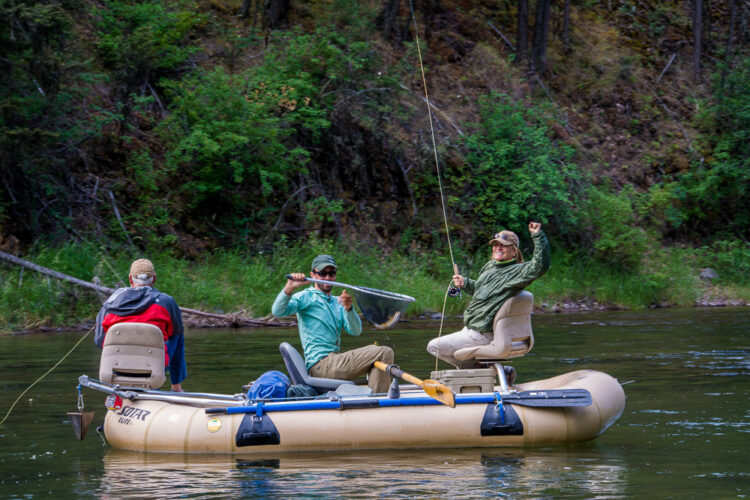
Blackfoot River Fishing Guide
Float fishing is the most common and effective way to fish the Blackfoot river. Depending on the time of year and stretch of river, Montana guides utilize either a fly fishing raft or drift boat to float anglers down the river. These boats are designed to accommodate one or two anglers comfortably.
The Blackfoot is the coldest river in the Missoula area and as a result, the last one to get going in terms of fishing each year. Snow and cold temperatures characterize the fly fishing in March and April. When the stars align just right there can be brief windows of excellent fishing in the spring, but often there are better fly fishing options around Missoula during the early season. The month of May is even more challenging as runoff typically takes place when the high elevation snow in the mountains melts. The result is high and off-color flows that make fly fishing difficult.
Blackfoot River Fishing Guide – Summer Months
June signals the arrival of the most anticipated fishing of the year on the Blackfoot. The giant Salmonfly hatch creates a frenzy among both anglers and trout. The Blackfoot river boasts one of the most prolific and longest Salmonfly hatches in the west. It generally starts around the second week of June and can last beyond July 4 most years. River flows are still high this time of year but the temptation to cast huge size 2 and 4 dry flies is too much to resist for fly rod enthusiasts from all over the globe.
Missoula fly fishing guides spend as much time as possible on the Blackfoot in June. They know that the biggest trout of the season will be caught during the fabled Salmonfly hatch. Rainbow and brown trout over 20 inches are a possibility any day and cutthroat trout as fat as footballs are common. Strong hatches of Green Drakes and Golden Stoneflies add to the daily dry fly buffet as June progresses.
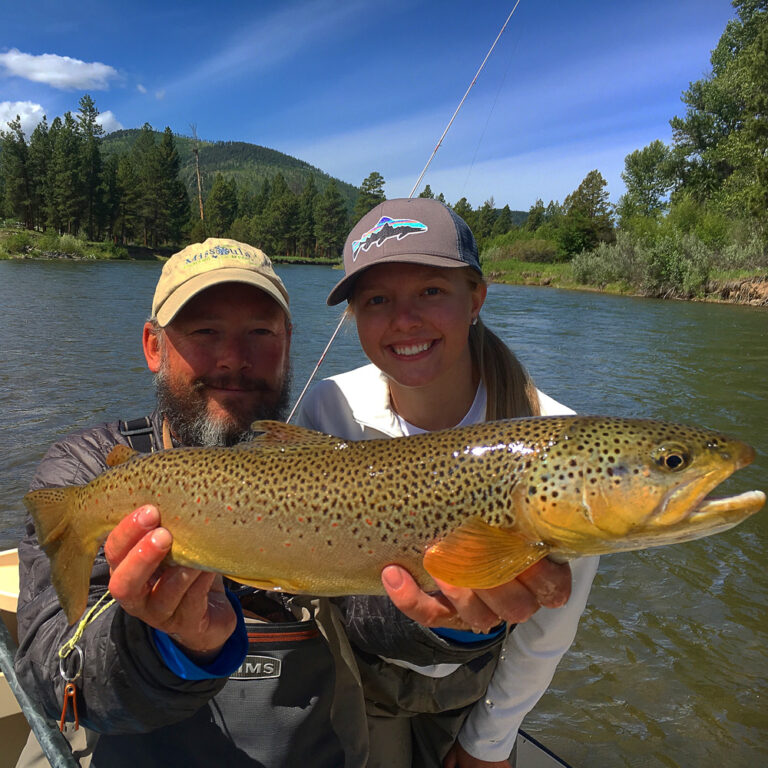
Blackfoot River Fishing Guide
Fly Fishing near Missoula, Montana
The transition to summer fly fishing conditions occurs in July on the Blackfoot river. River conditions begin to clear and drop to reveal deep pools, boulder-filled pocket water, and long riffles. New bug hatches take place as well. Green Drakes and Golden Stones extend into July and are joined by Pale Morning Duns, Caddis, and Yellow Sallies. These smaller dry flies require lighter tippets and delicate presentations.
The clear water produces exciting visual strikes from trout on dry flies and occasionally thrilling moments when a giant bull trout appears from the depths to chase the wild trout on the end of an angler’s line. The Spruce Moth hatch starts in mid-to late July and can last 10-20 days. This is an unpredictable hatch that does not take place every season.
Warm, dry years seem to be best and when the Spruce Moth hatch happens it offers some of the finest dry fly fishing of the season. For whatever reason, trout absolutely love moths and will throw caution to the wind when this hatch takes place.
August marks the beginning of hopper season for fly fishing in Montana and the Blackfoot is no exception. Grasshoppers, ants, and beetles will all move to the top of the menu for dry fly eating trout. August is when the Blackfoot really shines among Missoula area rivers. Since its flows are colder than other streams the fishing often remains consistent even during the peak of summer.
There is nothing quite like watching a trout smash a hapless hopper imitation that lands near the bank, or convincing a tough fish to sip a dainty ant pattern. Terrestrials like grasshoppers and ants make up the bulk of dry fly fishing this time of year, but the Blackfoot does see hatches of Trico mayflies and occasionally Hecubas, or fall drakes. Trico fishing is a fun and technical game with tiny dry flies while the Hecuba is a big size 10 or 12.
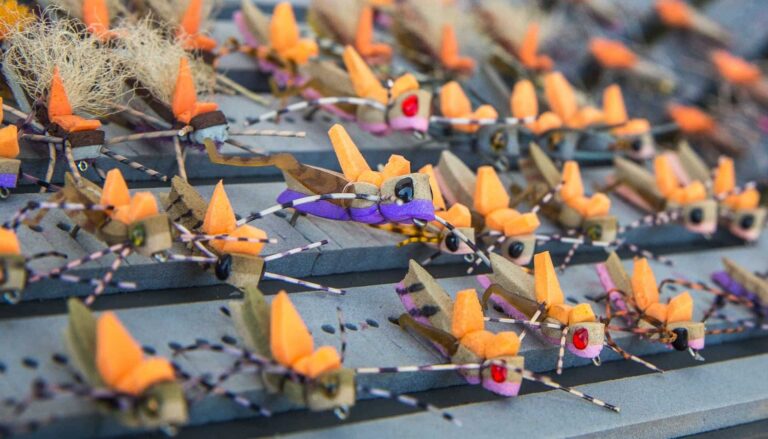
Blackfoot River Fishing Guide - Hopper Season
Hopper fishing remains strong as fall arrives in Montana during September. Water temperatures cool off and the wild trout respond by feeding aggressively before winter arrives. Mayfly hatches of Blue-wing Olives and Mahogany Duns continue to raise trout for dry flies throughout the fall. This is also prime time for streamer fishing on the Blackfoot. Big rainbow and cutthroat trout will recklessly chase streamers in the fall and large brown trout are also assertive during their pre-spawn time period.
The Blackfoot offers an outstanding variety of fishing options over the course of a season. As a result, Missoula fly fishing guides employ a wide array of techniques to find success on the river. Casting a single dry fly is effective and one of the most enjoyable tactics. Fly fishing with a dry/dropper rig is common and can result in a good number of trout landed during a day of float fishing. During periods of high water the most successful technique is often a strike indicator nymph rig with two different nymphs fished below the surface. Streamer fishing with large flies can produce any time of year as well.
Fortunately fly fishing tackle for the Blackfoot river is not that complicated. Most anglers fish with a 9’ 5 or 6 weight rod. It does not matter much if it is a Winston fly rod or Temple Fork, any modern 5 or 6 weight will work. In the hands of an experienced fly caster, a 9’ 4 weight also has a place when dry fly fishing. Weight forward floating fly lines are standard for most situations while sink-tip fly lines can help when streamer fishing. For leaders it is a good idea to have 7.5’ 3X on hand for fishing big dries like hoppers and stoneflies and 9’ 4X or 5X for fishing smaller dry flies. Spools of tippet in 3X, 4X and 5X are also essential.
The Blackfoot river is one that should be on every serious fly anglers bucket list. The scenic beauty is worth the trip alone, but it is often the strong wild trout that draw anglers back year after year.
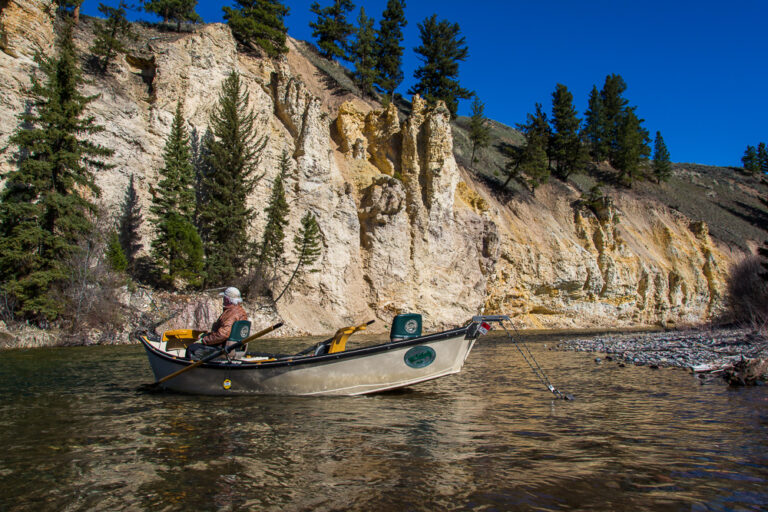
Tony Reinhardt
Tony Reinhardt is the owner of Montana Trout Outfitters and has been guiding anglers on the waters of western Montana since 1998. For over twenty years Tony has passionately been introducing and guiding people to the joy of fly fishing.
While some Montana outfitters claim to have experience – Tony is one who walks the talk. As Mark Twain said; “The secret of success is making your vocation your vacation.”
Tony as one who has embraced and lives this quote to this day, Tony welcomes you to join him for an unparalleled fly fishing experience in Missoula. As one of the leaders in Montana’s outfitter services, Tony will ensure a fly fishing trip that won’t be soon forgotten. Blackfoot River Fishing Guide – Book Your Trip Today!

Subscribe to Tony's Fishing Reports Newsletter


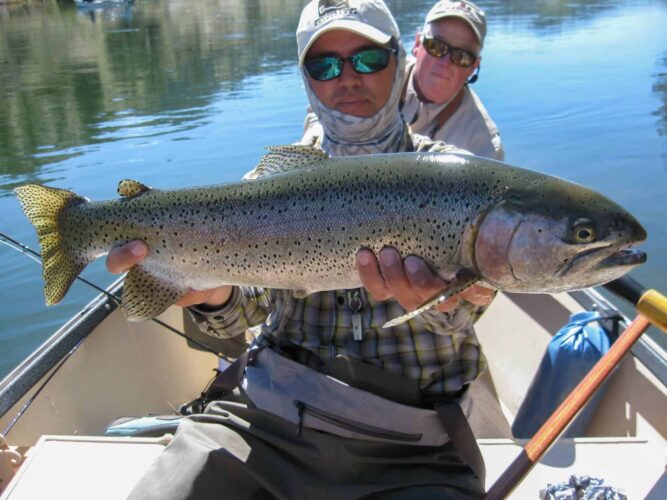
Receive Tony's Weekly Fly Fishing Reports All Season Long
Experience fly fishing the Bitterroot, the Blackfoot, the Clark Fork rivers, as well as Rock Creek and the Missouri river, as Tony Reinhardt recounts in detail each week’s fishing adventures along with plenty of beautiful pictures.
Plus receive a BONUS pdf on “5 Easy Tips to More Trout” when you sign up.
It’s the next best thing to being in the boat with Tony….
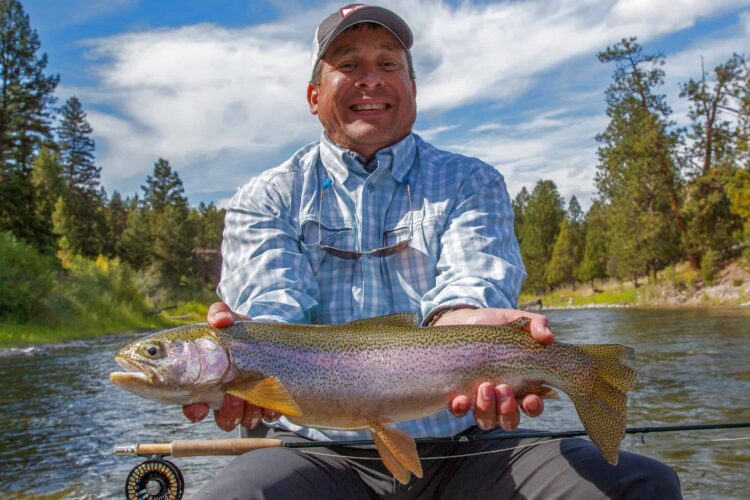


Call TODAY! 406-544-3516
Let’s Go Trout Fishing in Beautiful Montana
Give Tony a call – He can line you up with the Montana fly fishing lodges that will keep you and your family taken care of.
Montana Trout Outfitters
Proud Sponsors of
Cast One for Hope
Sept. 25-26,2021
An Exclusive Fly Fishing Event on the Legendary Bitterroot River to Benefit Women with Breast Cancer – Learn More
